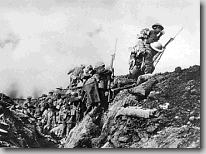Monday, November 06, 2006
WEEK OF REMEMBRANCE - THE SOMME

"The Canadians played a part of such distinction that thenceforward they were marked out as storm troops; for the remainder of the war they were brought along to head the assault in one great battle after another. Whenever the Germans found the Canadian Corps coming into the line they prepared for the worst."
-David Lloyd George, then British Secretary of War, on the Canadian contribution at the Battle of the Somme.
Battle of the Somme
Dates: 1 July 1916 - 18 November 1916
The Cost:
First day of fighting:
British casualties - 57,470; 1st Battalion, Newfoundland Regiment casualties - 680 (85% of initial strength)
Total:
Britain and Empire casualties - 419,645; dead 125,000
Canadian casualties - 24,029
French casualties - 204,253
Summary:
The Battle of the Somme was the principal campaigns of 1916 and one of the major battles of the First World War. The offensive was intended to be the "Big Push" designed to break the German front lines and open the way for cavalry attacks on the enemy's rear lines. Preceded by a week of intense artillery barrages the infantry assault began at 07:30 on 1 July 1916. On the northern offensive lines relatively new British recruits were decimated by German machine gun positions that had escaped the artillery barrage. In the south, advances were more successful with most first day objectives accomplished. The 1st Newfoundland battalion was particularly distinguished in their brave assault on Beaumont-Hamel in which they faced intense enemy defenses. Following the battle British Army Captain G.E Malcolm stated, "I should like to congratulate the Newfoundland Regiment on their extreme steadiness under trying conditions," perhaps one of the greater understatements of the 20th century.
As the battle continued through July, British Army commanders realized the larger objectives were not going to be obtained and the battle became one of attrition. Four divisions of the Canadian Corps joined the battle in September, relieving the Australians at Poizeres. For the next two months Canadians fought continuously and heroically between Courcelette and Grandcourt capturing several important German positions. By mid-November the on-set of winter weather brought the offensive to a halt.
The Result:
Through five months of fighting the British, Imperial, and French troops had gained six miles of ground and combined suffered more than 600,000 casualties. The Somme often epitomizes the absolute horror and, in many ways, futility of First World War fighting. Despite that, modern scholarship suggests that within the context of the war the battle was a devastating but necessary offensive needed to weaken the German forces and lay the foundation for victory. Following the war a German staff officer described the Somme as "the muddy grave of the German field army."
Sources:
For sources, interpretation, and more detailed accounts of the battle see the following links:
The Imperial War Museum - Battle of the Somme.
Canadian Department of Veterans Affairs - Battle of the Somme.
Veterans Affairs - Newfoundlanders at Beaumont Hamel.
BBC - Rethinking the Somme.
Read or Post a Comment
<< Home